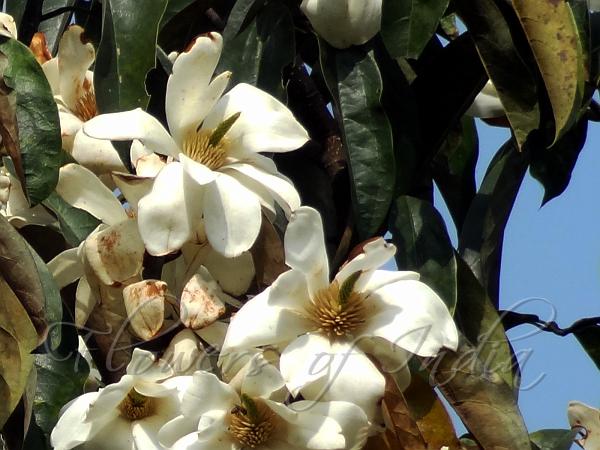|
| Manipur Magnolia |
|

|

| File size | 393581 |
| Original date | 2/12/13 11:37 AM |
| Resolution | 1600 x 1200 |
| Flash | Flash did not fire, auto |
| Focal length | 68.48mm |
| Exposure time | 1/250s |
| Aperture | 5.9 |
| Focus Distance | |
| Metering Mode | Multi-segment |
| Camera make | SONY |
| Camera model | DSC-HX9V |
| Sensor type |
|
|
|
|
Photo: |
Botanical name: Magnolia doltsopa Family: Magnoliaceae (Magnolia family)
Synonyms: Michelia doltsopa, Magnolia excelsa, Michelia manipurensis
Synonyms: Michelia doltsopa, Magnolia excelsa, Michelia manipurensis
Manipur Magnolia is an evergreen trees, native to the Himalayas, up to 30 m
tall. Young twigs, buds, leaf-stalks and leaf underside are covered with
grayish white velvety hairs. Stipular scar is about 1/5 as long as the
leaf-stalk. Leaf-stalks is 1-2 cm long. Leaves are elliptic, oblong-
elliptic, or narrowly elliptic, 10-22 cm long, 5-7 cm wide. The underside
of the leaves is greyish, base broadly wedge-shaped or blunt, margin
slightly incurled, apex pointed to long-pointed. Tepals are white,
narrowly obovate-spoon-shaped, 5-7 cm long, about 2.5 cm wide, base
clawed, tip rounded. Stamens are 1.2-1.7 cm long. Fruit is 4-7 cm; mature
carpels nearly obovoid, 1.5 cm. Manipur Magnolia is found in Eastern Himalaya,
from Nepal to NE India and Myanmar, at altitudes of 1500-2400 m.
Medicinal uses: Flower are crushed with water for extract, root dried and ground into
powder, bark crushed for decoction. Roots are used in dyspepsia, gonorrhea
and in stomach complain. Flower extract is applied to head for eradicating
lice and also applied for tonsillitis. Bark is used in fever.
Flower are crushed with water for extract, root dried and ground into
powder, bark crushed for decoction. Roots are used in dyspepsia, gonorrhea
and in stomach complain. Flower extract is applied to head for eradicating
lice and also applied for tonsillitis. Bark is used in fever.
Medicinal uses:
 Flower are crushed with water for extract, root dried and ground into
powder, bark crushed for decoction. Roots are used in dyspepsia, gonorrhea
and in stomach complain. Flower extract is applied to head for eradicating
lice and also applied for tonsillitis. Bark is used in fever.
Flower are crushed with water for extract, root dried and ground into
powder, bark crushed for decoction. Roots are used in dyspepsia, gonorrhea
and in stomach complain. Flower extract is applied to head for eradicating
lice and also applied for tonsillitis. Bark is used in fever. | Identification credit: Tabish | Photographed in Fambong-Lho Wildlife Sanctuary, Sikkim & Mussoorie, Uttarakhand. |
• Is this flower misidentified? If yes,